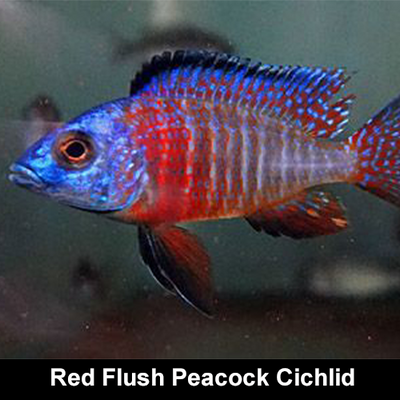News result Live Stock
Blog posts
Bluedorfin
Cyrtocara moorii, commonly known as the Blue Dolphin Cichlid or Malawi Blue Dolphin, is a species of cichlid native to Lake Malawi in East Africa. Here's some information about its pH, temperature, temperament, and maximum size:
-
pH: Cyrtocara moorii prefers alkaline water conditions. The ideal pH range for this species is typically between 7.8 to 8.6.
-
Temperature: Blue Dolphin Cichlids thrive in warm water temperatures. The recommended temperature range for this species is between 76°F to 82°F (24°C to 28°C). Maintaining stable temperature conditions within this range is important for their health and well-being.
-
Temperament: Cyrtocara moorii is generally peaceful compared to many other cichlid species from Lake Malawi. They are known for their gentle and docile temperament, making them suitable for community aquariums with other non-aggressive fish species. However, they can become territorial, especially during breeding. Providing plenty of space and hiding spots in the aquarium can help minimize aggression.
-
Maximum size: Blue Dolphin Cichlids are relatively large cichlid species. Adult individuals typically reach a maximum size of around 8 to 10 inches (20 to 25 centimeters) in length.
Blue Dolphin Cichlids are known for their unique appearance, with a streamlined body and elongated forehead resembling a dolphin. They have a striking blue coloration with black vertical bars and bright yellow markings around their fins and face.
Feeding Cyrtocara moorii is relatively easy, as they are omnivorous and accept a variety of foods. They can be fed high-quality cichlid pellets or flakes supplemented with occasional live or frozen foods like brine shrimp, bloodworms, or daphnia.
Maintaining excellent water quality, providing appropriate tank decor and hiding spots, and offering a balanced diet are essential for the health and well-being of Blue Dolphin Cichlids in captivity. Regular water changes and monitoring of water parameters are also important to ensure optimal conditions for these beautiful cichlids.
Red Peacock
Aulonocara rubescens, commonly known as the Ruby Red Peacock, is a species of cichlid native to Lake Malawi in East Africa. Here's some information about its pH, temperature, temperament, and maximum size:
-
pH: Aulonocara rubescens prefers alkaline water conditions. The ideal pH range for this species is typically between 7.8 to 8.6.
-
Temperature: Ruby Red Peacocks thrive in warm water temperatures. The recommended temperature range for this species is between 76°F to 82°F (24°C to 28°C). Keeping the water within this range helps maintain their health and well-being.
-
Temperament: Aulonocara rubescens is generally peaceful compared to many other cichlid species from Lake Malawi. However, they can display some territorial behavior, especially during breeding. It's recommended to keep them in groups with plenty of space and hiding spots to minimize aggression. They can be kept in a community setup with other Lake Malawi cichlids of similar size and temperament.
-
Maximum size: Aulonocara rubescens is a relatively small to medium-sized cichlid species. Adult individuals typically reach a maximum size of around 4 to 6 inches (10 to 15 centimeters) in length, with males being slightly larger and more colorful than females.
Ruby Red Peacocks are known for their stunning colors, with males exhibiting vibrant red hues and females displaying more subdued colors. They are sexually dimorphic, with males typically being larger and more colorful than females.
Feeding Aulonocara rubescens is relatively easy, as they are omnivorous and accept a variety of foods. They can be fed high-quality cichlid pellets or flakes supplemented with occasional live or frozen foods like brine shrimp, bloodworms, or daphnia.
Maintaining excellent water quality, providing appropriate tank decor and hiding spots, and offering a balanced diet are essential for the health and well-being of Ruby Red Peacocks in captivity. Regular water changes and monitoring of water parameters are also important to ensure optimal conditions for these beautiful cichlids.
Albino Nyassae
Aulonocara nyassae, commonly known as the Nyasa Peacock or Lake Malawi Peacock, is a popular freshwater fish species native to Lake Malawi in East Africa. Here's some information about its pH, temperature, temperament, and maximum size:
-
pH: Aulonocara nyassae prefers alkaline water conditions. The ideal pH range for this species is typically between 7.8 to 8.6.
-
Temperature: Nyasa Peacocks thrive in warm water temperatures. The recommended temperature range for this species is between 76°F to 82°F (24°C to 28°C). Keeping the water within this range helps maintain their health and well-being.
-
Temperament: Aulonocara nyassae is generally peaceful and non-aggressive compared to many other cichlid species from Lake Malawi. However, they can display some territorial behavior, especially during breeding. It's recommended to keep them in groups with plenty of space and hiding spots to minimize aggression. They can be kept in a community setup with other Lake Malawi cichlids of similar size and temperament.
-
Maximum size: Aulonocara nyassae is a relatively small to medium-sized cichlid species. Adult individuals typically reach a maximum size of around 4 to 6 inches (10 to 15 centimeters) in length, with males being slightly larger and more colorful than females.
Nyasa Peacocks are known for their stunning colors and unique patterns, especially in males. They are sexually dimorphic, with males displaying more vibrant colors, including blues, yellows, and oranges, while females are usually less colorful.
Feeding Aulonocara nyassae is relatively easy, as they are omnivorous and accept a variety of foods. They can be fed high-quality cichlid pellets or flakes supplemented with occasional live or frozen foods like brine shrimp, bloodworms, or daphnia.
Maintaining excellent water quality, providing appropriate tank decor and hiding spots, and offering a balanced diet are essential for the health and well-being of Nyasa Peacocks in captivity. Regular water changes and monitoring of water parameters are also important to ensure optimal conditions for these beautiful cichlids.






